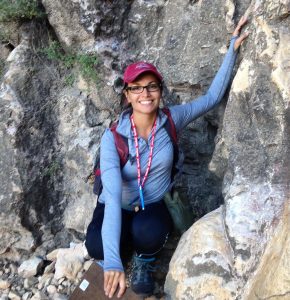Determining Radiocarbon Reservoir-corrections for Freshwater Mollusks from Ancient Lake Cahuilla, Imperial County, California

Liz White
MS Candidate
Advisor: Dr. Tom Rockwell
June 14th, 2017 – CSL 422, 9 am
watch Liz’s defense
Abstract
To better understand the timing of Lake Cahuilla’s six most recent lake highstands, I conducted a study to analyze the potential of using radiocarbon derived from freshwater mollusk shells to directly date the lakes. Conventional methods for dating the lakes in the past, such as using radiocarbon from charcoal, does not represent the timing of inundation, but instead represents the timing of dry periods between lakes. 27 Physa humerosa and 9 Anodonta dejecta shells were collected from a 3.0-meter-wide and 2.0-meter-deep excavation of an arroyo wall along the ancient southern shoreline of Lake Cahuilla (Carrizo South Shoreline) and from a former collection site at Carrizo Wash located in Imperial County, California. These specimens, along with 59 additional specimens from previous Lake Cahuilla studies, were analyzed for 14C and calibrated into calendar dates using OxCal software. The results were then used to calculate 11 potential reservoir-corrections (ΔR) necessary to adjust lakes calendar dates to appropriate ages as determined by a recently developed Lake Cahuilla chronologic model by Rockwell et al., (2017). Two corrections, 379±32 years B.P. and 361±18 years B.P. were developed for Lake 1. A single correction of 247±44 years B.P. was determined for Lake 2. Two corrections, 640±95 years B.P. and 603±62 years B.P., were used for Lake 3. Two corrections, 192±16 years B.P. and 343±14 years B.P. were used for Lake 4. Two corrections, 246±41 years B.P. and 475±59 years B.P. were developed for Lake 5. Lastly, one correction of 376±10 years B.P. was calculated for Lake 6. From this data, I concluded that a single reservoir-correction average was no adequate for adjusting shells dates for Lake Cahuilla. Also during the process of calculating reservoir-corrections, evidence of reworking of many of the shells became apparent, and that the ages of Lakes 4 and 5 at the Carrizo Wash site are not consistent with ages determined by other Lake Cahuilla sites. Lastly, three Lake Cahuilla highstand chronologic models were constructed using non-reworked Physa specimens. The models suggest that using lake-specific reservoir-corrections is the most accurate way to date Lake Cahuilla highstands, and that a global Lake Cahuilla correction (ΔRaverage = 410±134) is not likely using the current dataset.

